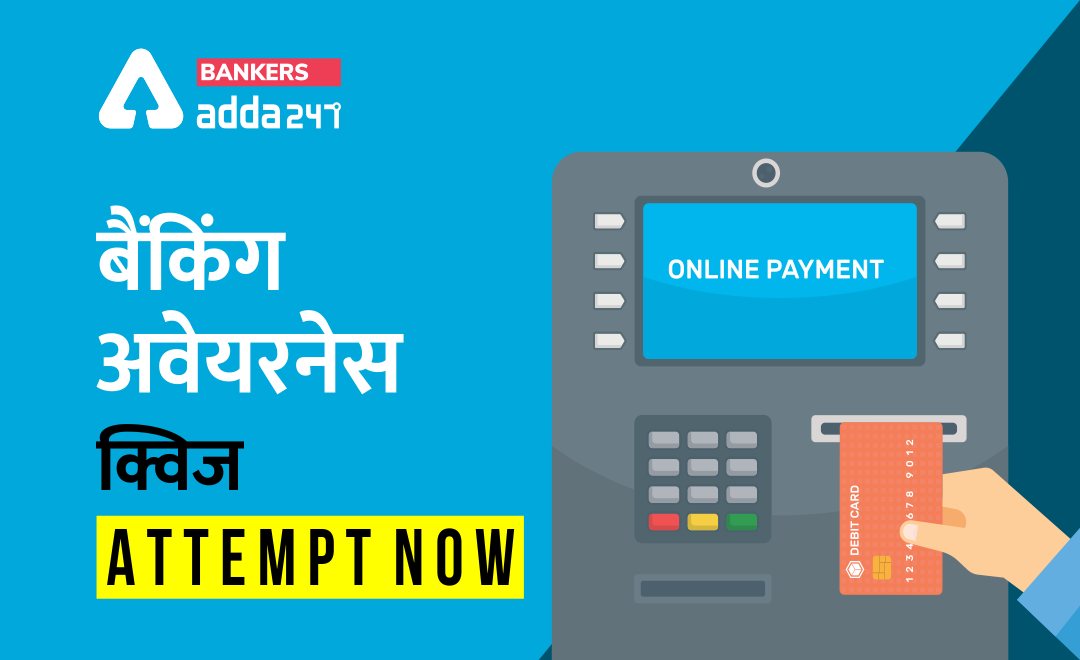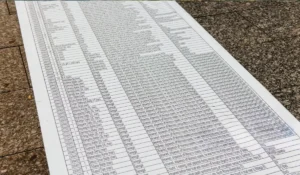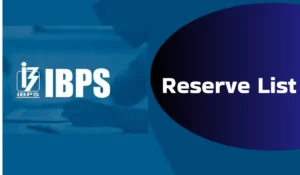
बैंकिंग अवेयरनेस प्हैरतियोगी परीक्षाओं का एक अहम हिस्सा है और परीक्षा में सफलता प्राप्त करने के लिए इस विषय पर ध्यान केन्द्रित करना बेहद आवश्यक है. इसके साथ ही आपको static awareness और general awareness पढ़ने भी ज़रूरी हैं. Hindi Bankersadda, RBI Assistant Main 2020 और SBI Clerk Mains 2020 परीक्षा के लिए General Awareness क्विज़ में सभी important और expected प्रश्न उपलब्ध कराता है. ये क्विज़ RBI असिस्टेंट मेंस 30 Days Study Plan के According हैं. आप इसे क्लिक करके देख सकते हैं… click here
SBI Clerk Mains और RBI Assistant Mains जैसी आगामी परीक्षाओं के सामान्य जागरूकता अनुभाग में आपकी तैयारी को और बेहतर बनाने के लिए हम आपको 24 अगस्त, 2020 के स्टेटिक जीके अवेयरनेस क्विज प्रदान कर रहे हैं, जो निम्नलिखित विषय “DRTs, MUDRA, SEZ, लोकपाल, IBA, बॉन्ड” पर आधारित है. Solve करने के लिए नीचे दिए गए लिंक पर क्लिक करें…
Q1. किस समिति ने विशेष न्यायाधिकरण की स्थापना, मामलों को सुलझाने और सिफारिशों को स्वीकार करने के लिए आवश्यक समय कम करने के लिए किया है, जिसके कारण ऋण वसूली ट्रिब्यूनल्स (DRTs) की स्थापना की गई थी?
(a) केलकर समिति
(b) जस्टिस रेड्डी कमेटी
(c) रंगराजन समिति
(d) शिवरमन समिति
(e) नरसिमहम समिति
Q2. DRT बैंकों और वित्तीय संस्थानों अधिनियम, 1993 के कारण ऋण की वसूली की धारा 3 के तहत गठित किया गया है. DRT से क्या तात्पर्य है –
(a) Debt Recovery Tribunals
(b) Demand Recovery Tribunals
(c) Deposit Recovery Tribunals
(d) Debt Refinance Tribunals
(e) Debt Recovery Treaty
Q3. मुद्रा की तरूण योजना के अंतर्गत वित्तीय सीमा क्या है?
(a) 40 लाख रुपये से 50 लाख रुपये
(b) 30 लाख रुपये से 40 लाख रुपये
(c) 20 लाख रुपये से 30 लाख रुपये
(d) 10 लाख रुपये से 20 लाख रुपये
(e) 5 लाख रुपये से 10 लाख रुपये
Q4. SEZ कौन स्थापित कर सकता है?
(a) निजी क्षेत्र
(b) सार्वजनिक क्षेत्र
(c) राज्य सरकार
(d) उपरोक्त सभी
(e) केवल (a) और (b)
Q5. प्रतिभूतिकरण अधिनियम 2002 बैंकों को उन डिफाल्टर को नोटिस जारी करने में सक्षम बनाता है, जिन्होंने __________ दिनों के भीतर ऋण का भुगतान करना है.
(a) 90 दिन
(b) 60 दिन
(c) 30 दिन
(d) 120 दिन
(e) इनमें से कोई नहीं
Q6. निम्नलिखित में से कौन मौद्रिक नीति के संचालन की जिम्मेदारी के साथ निहित है?
(a) RBI
(b) SBI
(c) NABARD
(d) SIDBI
(e) वित्त मंत्रालय
Q7. भारतीय रिजर्व बैंक (RBI) अधिनियम, 1934 किस वर्ष में लचीली मुद्रास्फीति लक्ष्यीकरण ढांचे के कार्यान्वयन के लिए एक वैधानिक आधार प्रदान करने के लिए संशोधित किया गया था?
(a) मई 2013
(b) मई 2014
(c) मई 2015
(d) मई 2016
(e) मई 2012
Q8. बैंकों द्वारा प्रदान की जाने वाली कुछ सेवाओं से संबंधित शिकायतों के समाधान के लिए कौन-सी योजना/अधिनियम बैंक ग्राहकों के लिए एक शीघ्र और अल्पमूल्य मंच (expeditious and inexpensive forum) प्रदान करता है?
(a) भारतीय रिजर्व बैंक अधिनियम, 1934
(b) बैंकिंग विनियमन अधिनियम, 1949
(c) प्रतिभूतिकरण अधिनियम 2002
(d) FEMA
(e) बैंकिंग लोकपाल योजना
Q9. बैंकिंग लोकपाल योजना RBI द्वारा कब लागू की गई है?
(a) 1991
(b) 1995
(c) 1990
(d) 2002
(e) 2006
Q10. IBA बैंकिंग क्षेत्र से संबंधित किसी भी मुद्दे पर अपने विचार देने के लिए एक परामर्शी दृष्टिकोण अपनाता है। IBA में “I” का क्या अर्थ है?
(a) International
(b) Institute
(c) Investment
(d) Indian
(e) Increase
Q11. भारतीय रिज़र्व बैंक द्वारा दी गई ‘छोटे वित्त बैंकों’ की स्थापना के लिए ” सिद्धांततः (in-principle)” अनुमोदन कब तक मान्य होंगे-
(a) 12 महीने
(b) 24 महीने
(c) 10 महीने
(d) 18 महीने
(e) 30 महीने
Q12. निम्नलिखित में से कौन सी मुंबई में स्थित एक स्वतंत्र कमोडिटी एक्सचेंज है?
(a) MGEX
(b) MCE
(c) MDEX
(d) MCX
(e) MEX
Q13. निम्नलिखित में से कौन से असंबंधित क्षेत्र में श्रमिकों पर केंद्रित पेंशन योजना है?
(a) SSY
(b) AMRUT
(c) APY
(d) PMAY
(e) दिए गए विकल्पों में से कोई सत्य नहीं है
Q14. भारत के बाहर जारी एक भारतीय डॉमिनैटेड बॉन्ड को क्या कहा जाता है?
(a) यांकी बॉन्ड
(b) बुलडॉग बॉन्ड
(c) उरीदशी बॉन्ड
(d) समुराई बॉन्ड
(e) मसाला बॉन्ड
Q15. निम्नलिखित में से कौन विदेशी विनिमय लेनदेन के लिए “प्राधिकृत व्यापारी” नियुक्त करता है?
(a) GOI
(b) RBI
(c) PSBs
(d) FEDAI
(e) FIMMDA
SOLUTIONS:
S1. Ans.(e)
Sol. Narasimham Committee Report I (1991) recommended the setting up of Special Tribunals to reduce the time required for settling cases. Accepting the recommendations, Debt Recovery Tribunals (DRTs) were established.
S2. Ans.(a)
Sol. DRTs stands for Debt Recovery Tribunals.
S3. Ans.(e)
Sol. Under the aegis of PradhanMantri MUDRA Yojana (PMMY), MUDRA has already created its initial products/schemes. The interventions have been named ‘Shishu’, ‘Kishor’ and ‘Tarun’ to signify the stage of growth/development and funding needs of the beneficiary micro unit / entrepreneur and also to provide a reference point for the next phase of graduation / growth to look forward to. The financial limit for these schemes is:-
(a) Shishu:- covering loans up to 50,000/-
(b) Kishor:- covering loans above 50,000/- and up to 5 lakh
(c) Tarun:- covering loans above 5 lakh to 10 lakh
S4. Ans.(d)
Sol. Private sector, Public sector and State government can set up Special Economic Zones (SEZs).
S5. Ans.(b)
Sol. Securitisation and Reconstruction of Financial Assets and Enforcement of Security Interest Act 2002 is popularly known as Securitisation Act. This act enables the banks to issue notices to defaulters who have to pay the debts within 60 days. Once the notice is issued the borrower cannot sell or dispose the assets without the consent of the lender. The Securitisation Act further empowers the banks to take over the possession of the assets and management of the company. The lenders can recover the dues by selling the assets or changing the management of the firm. The Act also enables the establishment of Asset Reconstruction Companies for acquiring NPA.
S6. Ans.(a)
Sol. Monetary policy refers to the policy of the central bank with regard to the use of monetary instruments under its control to achieve the goals specified in the Act. The Reserve Bank of India (RBI) is vested with the responsibility of conducting monetary policy. This responsibility is explicitly mandated under the Reserve Bank of India Act, 1934.
S7. Ans.(d)
Sol. The primary objective of monetary policy is to maintain price stability while keeping in mind the objective of growth. Price stability is a necessary precondition to sustainable growth. In May 2016, the Reserve Bank of India (RBI) Act, 1934 was amended to provide a statutory basis for the implementation of the flexible inflation targeting framework.
S8. Ans.(e)
Sol. The Banking Ombudsman Scheme enables an expeditious and inexpensive forum to bank customers for resolution of complaints relating to certain services rendered by banks. The Banking Ombudsman Scheme is introduced under Section 35 A of the Banking Regulation Act, 1949 by RBI with effect from 1995.
S9. Ans.(b)
Sol. The Banking Ombudsman Scheme enables an expeditious and inexpensive forum to bank customers for resolution of complaints relating to certain services rendered by banks. The Banking Ombudsman Scheme is introduced under Section 35 A of the Banking Regulation Act, 1949 by RBI with effect from 1995.
S10. Ans.(d)
Sol. Indian Banks’ Association (IBA) set up in 1946 with 22 members to discuss issues of common interests. Over the years, IBA emerged as the Voice of Indian Banking Industry.
S11. Ans.(d)
Sol. The “in-principle” approval granted will be valid for 18 months to enable the applicants to comply with the requirements under the Guidelines and fulfil other conditions as may be stipulated by the RBI.
S12. Ans.(d)
Sol. Multi Commodity Exchange of India Ltd (MCX) is an independent commodity exchange based in India. It was established in 2003 and is based in Mumbai.
S13. Ans.(c)
Sol. Atal Pension Yojna (APY) a guaranteed pension scheme administered by PFRDA and established by Government of India. This scheme mainly for workers in unorganised sector.
S14. Ans.(e)
Sol. Masala bonds an Indian rupee denominated bond issued outside India.
S15. Ans.(d)
Sol. Foreign Exchange Dealer’s Association of India (FEDAI) was set up in 1958 as an Association of banks dealing in foreign exchange in India (typically called Authorised Dealers – ADs) as a self regulatory body and is incorporated under Section 25 of The Companies Act, 1956. It’s major activities include framing of rules governing the conduct of inter-bank foreign exchange business among banks vis-à-vis public and liaison with RBI for reforms and development of forex market.




 IBPS RRB PO 3rd Reserve List 2025 जारी: ...
IBPS RRB PO 3rd Reserve List 2025 जारी: ...
 IBPS RRB क्लर्क Reserve List: प्रोविजनल ...
IBPS RRB क्लर्क Reserve List: प्रोविजनल ...
 IBPS SO 3rd रिजर्व लिस्ट 2025 जारी, Prov...
IBPS SO 3rd रिजर्व लिस्ट 2025 जारी, Prov...








